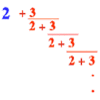Skip over navigation


Or search by topic
Number and algebra
Geometry and measure
Probability and statistics
Working mathematically
Advanced mathematics
For younger learners
Data Chunks
Age 14 to 16
Challenge Level 





- Problem
- Getting Started
- Student Solutions
- Teachers' Resources
Systematic working and recording of results help a lot here.
Conjectures are important, and should be encouraged, but along with a challenge to really explain why any claim might be true generally.
We hope the problem will give students a genuine pleasure in discerning real structure, and lead their interest on into Number Theory.
The articles on the NRICH site (see link from problem page) are an excellent follow-on.
You may also like
Euler's Squares
Euler found four whole numbers such that the sum of any two of the numbers is a perfect square...
There's a Limit
Explore the continued fraction: 2+3/(2+3/(2+3/2+...)) What do you notice when successive terms are taken? What happens to the terms if the fraction goes on indefinitely?

